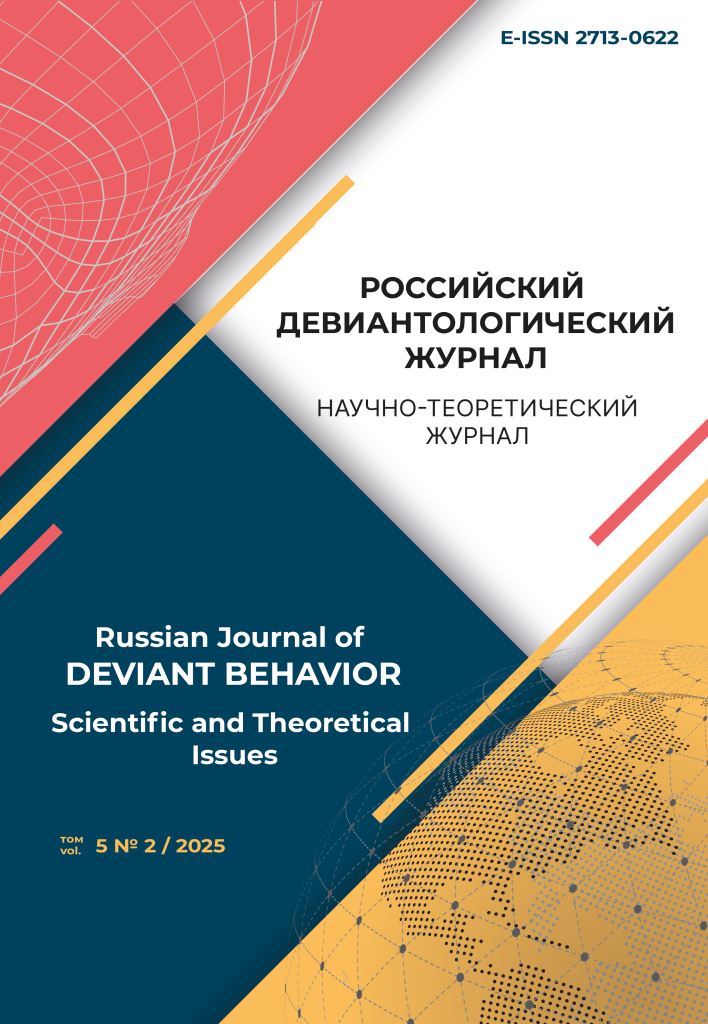Russian Federation
Russian Federation
Russian Federation
UDC 159.9
Introduction. The threat of radicalisation of young people is becoming the subject of scientific discussions, search and researches, most of which are concentrated within the examination of three components: personality-behaviour-environment. The concept of pattern seems to be more effective in solving the tasks of radicalisation risk management compared to the personological approach. The aim of the research is to analyse the prerequisites for radicalisation of young people on the basis of a metaanalysis of two empirical researches: one examining the individuals having committed terrorist offences and the other studying the psychological safety of the educational environment in connection with the aggressiveness and depression of students. The structure of the radical pattern described for convicted terrorists is formed by a complex of individual-psychological characteristics and social factors: personal dispositions, addictive behaviour, victimisation, radical religious worldview, fixation on the idea of justice, ideologically shaped identity core, family system disbalance and deficiency, and behavioural warning signs. In certain crisis conditions and under the influence of catalysing factors, this pattern can be activated and realised through a terrorist act. Aggressiveness, depression, lack of trust and support among peers and teachers, experience of violence, deficit of prosocial activity identified among students can be considered as prerequisites for the formation of a radical pattern in adolescence and young adulthood. The nature of interaction between predictors in such conditions and the regularities of the long-term dynamics of the system directed towards radicalisation is expected to be determinant (causal). Methodology, methods and techniques. Methodological foundations of the research are based on the concept of psychological safety of the educational environment, subjectactivity approach, regarding psychological safety of both an individual and his/her environment in integrity, as well as the risk-resource approach, aimed at identifying threats and preventing risks arising in the environment and affecting the psychological safety of subjects in the environment. The empirical research is aimed at describing the radical pattern as a variant of personal adaptation and identifying the prerequisites for radicalisation in the educational environment. The following methods for collecting data in the convicts’ examination were used: in-depth interview; analysis of demographic and socio-psychological indicators, considered important from the point of view of socialisation and radicalisation of the personality; eight psychodiagnostic test techniques: shortened multifactor personality research questionnaire, value orientations (methods by M. Rokeach and D. A. Leontiev), locus of control, psychological defences (Life Style Index questionnaire by R. Plutchik, H. Kellerman, H. R. Conte), coping strategies (R. Lazarus questionnaire), tendency to addictive behaviour (V. D. Mendelevich questionnaire). Monitoring of psychological safety of the educational environment was conducted via electronic survey. It included a questionnaire (33 questions concerning the educational space, relations with teachers and peers, family situation, involvement in violence, including bullying), psychodiagnostic examination of the level of depression (V. Zung scale adapted by T. I. Balashova) and aggressiveness (Buss-Perry Aggression Questionnaire (BPAQ-24) adapted by S. N. Enikolopov and N. P. Tsibulsky). Method of processing the results: correlation and comparative analysis. The sample of the research consisted of 30 persons convicted for terrorist offences and 30 members of their families; 244,143 respondents from 12 to 23 years old: schoolchildren of grades 6-11, students of secondary specialised and higher educational organisations in Kazan and different regions of the Republic of Tatarstan; 52.7 % among them were males and 47.3 % were females. Results. The characteristics of the radicalisation pattern reflecting the behavioural manifestations of the personality as well as the characteristics of the radicalised personality are presented. The characteristics of the environment, interaction with which contributes to the formation of radicalisation pattern, are determined. Scientific novelty. The findings expand the understanding of the causes of radicalisation of young people, shifting the research focus to diagnosing developmental disorders and describing the pattern of adaptation. Practical significance. The process of radicalisation pattern formation can be considered as one of the trajectories of a complex social deviation and as a variant of dysontogenesis arising in the process of personality interaction with unsafe environmental conditions. The use of such an approach in psychocorrective and psychopreventive work with young people and students is considered as a way to identify personality development disorders at early stages and to provide targeted psychological and pedagogical intervention.
radicalisation, radicalisation pattern, sanogenic and pathogenic adaptation patterns, predictors of radicalisation
1. Bovin, B. G., Bovina, I. B., Tihonova, A. D. (2021). Radikalizaciya: social'no-psihologicheskij vzglyad (Chast' III). Psihologiya i pravo, 11 (1), 181–194. https://doi.org/10.17759/psylaw.2021110114
2. Bovin, B. G., Dvoryanchikov, N. V., Mel'nikova, D. V., Bovina, I. B. (2023). K probleme ocenki riska radikalizacii v podrostkovo-molodezhnoj srede: nekotorye empiricheskie fakty. Penitenciarnaya nauka, 17 (1), 89–97. https://doi.org/10.46741/2686-9764.2023.61.1.010
3. Bovin, B. G., Kazberov, P. N., Bovina, I. B. (2021). Mekhanizmy psihologicheskoj zashchity i dominiruyushchee zashchitnoe povedenie osuzhdennyh za terroristicheskuyu i ekstremistskuyu deyatel'nost'. Psihologiya i pravo, 11 (2). 86–105. https://doi.org/10.17759/psylaw.2021110207
4. Davydov, D. G., Hlomov, K. D. (2017). Metodika diagnostiki dispozicij nasil'stvennogo ekstremizma. Psihologicheskaya diagnostika, 14 (1), 78–97.
5. Enikolopov, S. N. (2006). Terrorizm i agressivnoe povedenie. Nacional'nyj psihologicheskij zhurnal, 1, 28–32.
6. Zhemchugova, A. A. (2020). Empiricheskoe issledovanie spravedlivosti v strukture kognitivnyh konstruktov lichnosti, podpavshej pod vliyanie radikal'nyh ideologij. V Deviantnost' VS ekstremizm: issledovaniya, zakonomernosti, rekomendacii: kollektivnaya monografiya (str. 73–80). Kazan': Institut pedagogiki, psihologii i social'nyh problem.
7. Zaharova, N. M., Baeva, A. S., Sobolev, N. A. (2018). Social'no-psihologicheskie posledstviya sovremennogo terrorizma. Psihologiya i pravo, 18 (3), 190–205. https://doi.org/10.17759/psylaw.2018080314
8. Zlokazov, K. V. (2023). Izmerenie riska religioznoj radikalizacii molodezhi: konstrukt i oprosnik. Rossijskij deviantologicheskij zhurnal, 3 (2), 155–172. https://doi.org/10.35750/2713-0622-2023-2-155-172
9. Kazberov, P. N., Bovin, B. G., Fasolya, A. A. (2019). Psihologicheskij profil' terrorista. Psihologiya i pravo, 9 (3), 141–157. https://doi.org/10.17759/psylaw.2019090311
10. Kroz, M. V., Ratinova, N. A. (2022). Cennostnye orientacii prestupnikov-terroristov. Psihologiya i pravo, 12 (2), 99–110. https://doi.org/10.17759/psylaw.2022120208
11. Nichiporenko, N. P. (2021). Specifika vospriyatiya nekotoryh aspektov obrazovatel'noj sredy obucha-yushchimisya gruppy riska. Kazanskij pedagogicheskij zhurnal, 5 (148), 267–273. https://doi.org/10.51379/KPJ.2021.149.5.037
12. Nichiporenko, N. P., Pacakula, I. I. (2021). K voprosu o psihologii bezopasnosti lichnosti i sredy: granicy vzaimodejstviya v situacii konflikta interesov. V Deviantnost' & ekstremizm: global'noe, social'noe, lichnostnoe: kollektivnaya monografiya (vypusk 3., str. 110–124). Kazan': Institut pedagogiki, psihologii i social'nyh problem.
13. Nichiporenko, N. P. (2022). Sanogennye i patogennye patterny adaptacii v rakurse sistemno-evolyucionnogo podhoda. Kazanskij pedagogicheskij zhurnal, 4 (153), 263–274. https://doi.org/10.51379/KPJ.2022.154.4.032
14. Nichiporenko, N. P. (2023a). Vzaimosvyaz' urovnya depressii s harakteristikami obrazovatel'noj sredy v podrostkovo-yunosheskom vozraste. Kazanskij pedagogicheskij zhurnal, 2 (157), 192–199. https://doi.org/10.51379/KPJ.2023.159.2.025
15. Nichiporenko, N. P. (2023b). Psihologicheskoe soprovozhdenie kontingenta OV s uchetom social'noj situacii razvitiya: ot deviacii k norme. V Deviantnost' i ekstremizm: metodologiya, narrativy, issledovatel'skaya optika: kollektivnaya monografiya. (2-e izd., pererab. i dop.) (str. 23–32). Kazan': Izd-vo MMSIP.
16. Nichiporenko, N. P. (2024). Prediktory destruktivnogo i autodestruktivnogo povedeniya v rakurse sistemnogo podhoda. V Traektoriya social'nogo otkloneniya v razvitii lichnosti: prakticheskie i metodologicheskie aspekty: kollektivnaya monografiya (str. 107–118). Moskow: Federal'nyj nauchnyj centr psihologicheskih i mezhdisciplinarnyh issledovanij
17. Nichiporenko, N. P., Pacakula, I. I., Galiev, I. Sh. (2025). Ot diagnostiki lichnosti k diagnostike patterna: opyt issledovaniya lic, sovershivshih prestupleniya terroristicheskoj napravlennosti. Psihologiya i pravo, 15 (1), 16–28. https://doi.org/10.17759/psylaw.2025150102
18. El'zesser, A. S. (2024). Postroenie modeli radikalizacii i ee empiricheskaya proverka. Psihologiya i pravo, 14 (1), 89–106. https://doi.org/10.17759/psylaw.2024140106
19. Atran, S. (2021). Psychology of Transnational Terrorism and Extreme Political Conflict. Annual review of psychology, 72, 471–501. https://doi.org/10.1146/annurev-psych-010419-050800
20. Gill, P. (2015). Toward a scientifc approach to identifying and understanding indicators of radicalization and terrorist intent: Eight key problems. Journal of Threat Assessment and Management, 2 (3–4), 187–191. http://dx.doi.org/10.1037/tam0000047
21. Guldimann, A., & Meloy, J. R. (2020). Assessing the threat of lone-actor terrorism: the reliability and validity of the TRAP-18. Forens Psychiatr Psychol Kriminol, 14, 158–166. https://doi.org/10.1016/j.psc.2016.07.004
22. Höffler, K., Meyer, M., & Möller, V. (2022). Risk Assessment – the Key to More Security? Factors, Tools, and Practices in Dealing with Extremist Individuals. Eur J Crim Policy Res, 28, 269–295. https://doi.org/10.1007/s10610-021-09502-6
23. Meloy, J. R. (2018). The Operational Development and Empirical Testing of the Terrorist Radicalization Assessment Protocol (TRAP–18). Journal of Personality Assessment, 100 (5), 483–492. https://doi.org/10.1080/00223891.2018.1481077
24. Nichiporenko, N. P., & Zhemchugova, A. (2021). Psychological safety as a characteristic feature of common education environment of higher educational institutions in times of globalization. In M. Vidrevich (Ed.), SHS Web of Conferences. International Scientific Conference “Delivering Impact in Higher Education Learning and Teaching: Enhancing Cross-Boarder Collaborations” (DIHELT 2021). URL: https://www.shs-conferences.org/articles/shsconf/abs/2021/10/contents/contents.html
25. Ramasamy, R. (2021). Youth radicalization and violent extremism: a study of pathways in the post-war context of Sri Lanka. Journal of Youth Studies, 26 (2), 229–249. https://doi.org/10.1080/13676261.2021.2010684
26. Van den Bos, K. (2020). Unfairness and Radicalization. Annual review of psychology, 71, 563–588. https://doi.org/10.1146/annurev-psych-010419-050953
27. Vicente, Á. (2022). Terrorist Participation Despite Social Influences Opposing Violent Extremism: A Qualitative Study among Young Jihadists in Spain. Studies in Conflict & Terrorism, 1–24. https://doi.org/10.1080/1057610X.2022.2151094














